Crime Prevention: Analysis of the 'Last Drinks' Program in NSW Essay
VerifiedAdded on 2019/11/26
|9
|2493
|149
Essay
AI Summary
This essay examines the 'Last Drinks' program in New South Wales (NSW) as a case study in alcohol abuse prevention, particularly targeting alcohol-related violence. It critically analyzes the program's initiatives, such as restrictions on late-night alcohol sales and venue lockouts, arguing for their effectiveness in addressing the growing issue of alcohol-related crime in NSW. The essay explores the program's alignment with social learning and community crime prevention theories, highlighting its focus on primary prevention strategies. It also acknowledges the program's limitations, such as the lack of awareness programs, and compares it to other crime prevention models, such as the Newcastle program. The analysis covers situational, developmental, and community prevention approaches, assessing the program's potential to reduce alcohol-fueled violence and its consistency with the understanding of crime as a societal issue. The essay references multiple studies and empirical evidence to support its arguments, concluding that the program's strategies are well-suited to addressing alcohol-related crime in NSW.
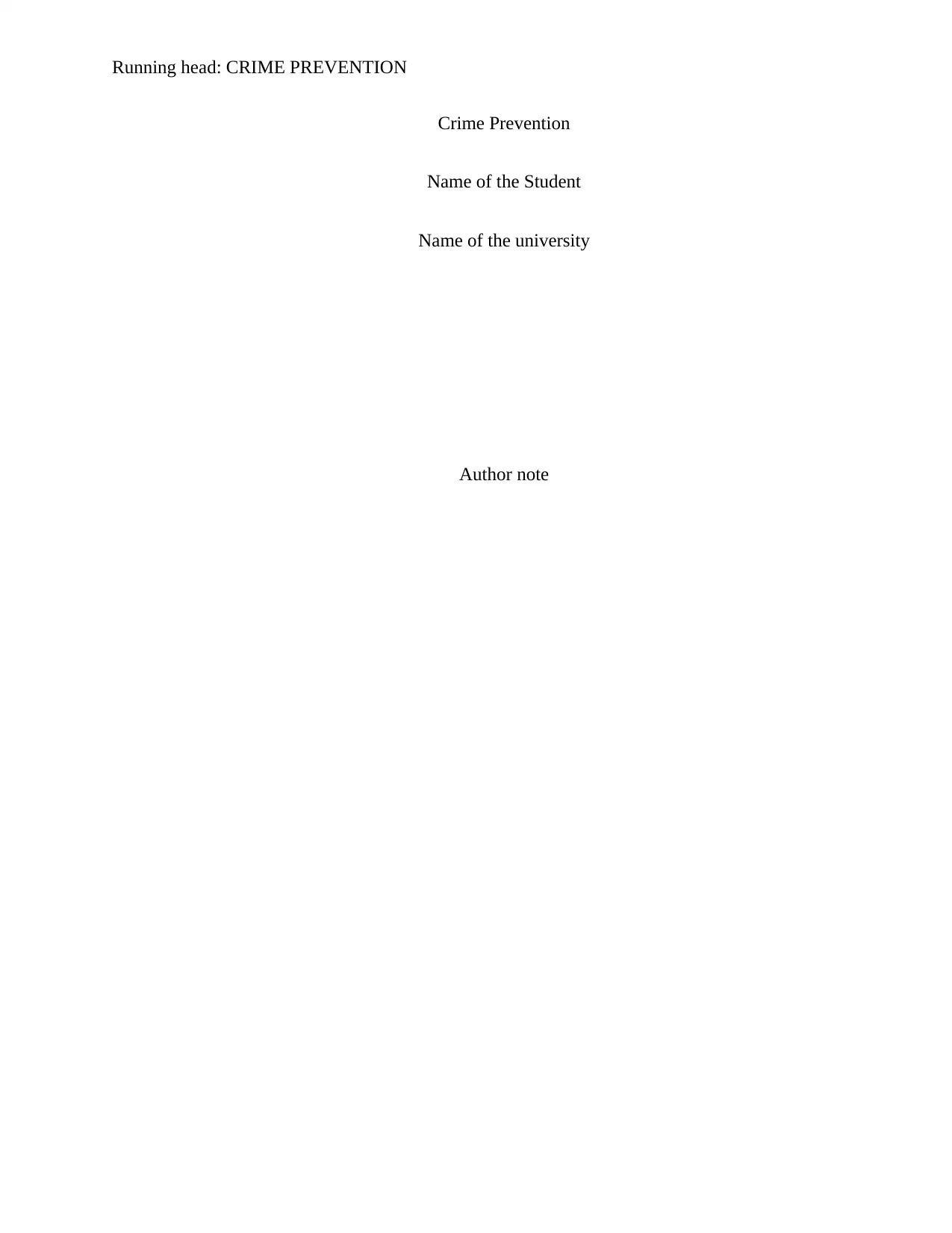
Running head: CRIME PREVENTION
Crime Prevention
Name of the Student
Name of the university
Author note
Crime Prevention
Name of the Student
Name of the university
Author note
Paraphrase This Document
Need a fresh take? Get an instant paraphrase of this document with our AI Paraphraser
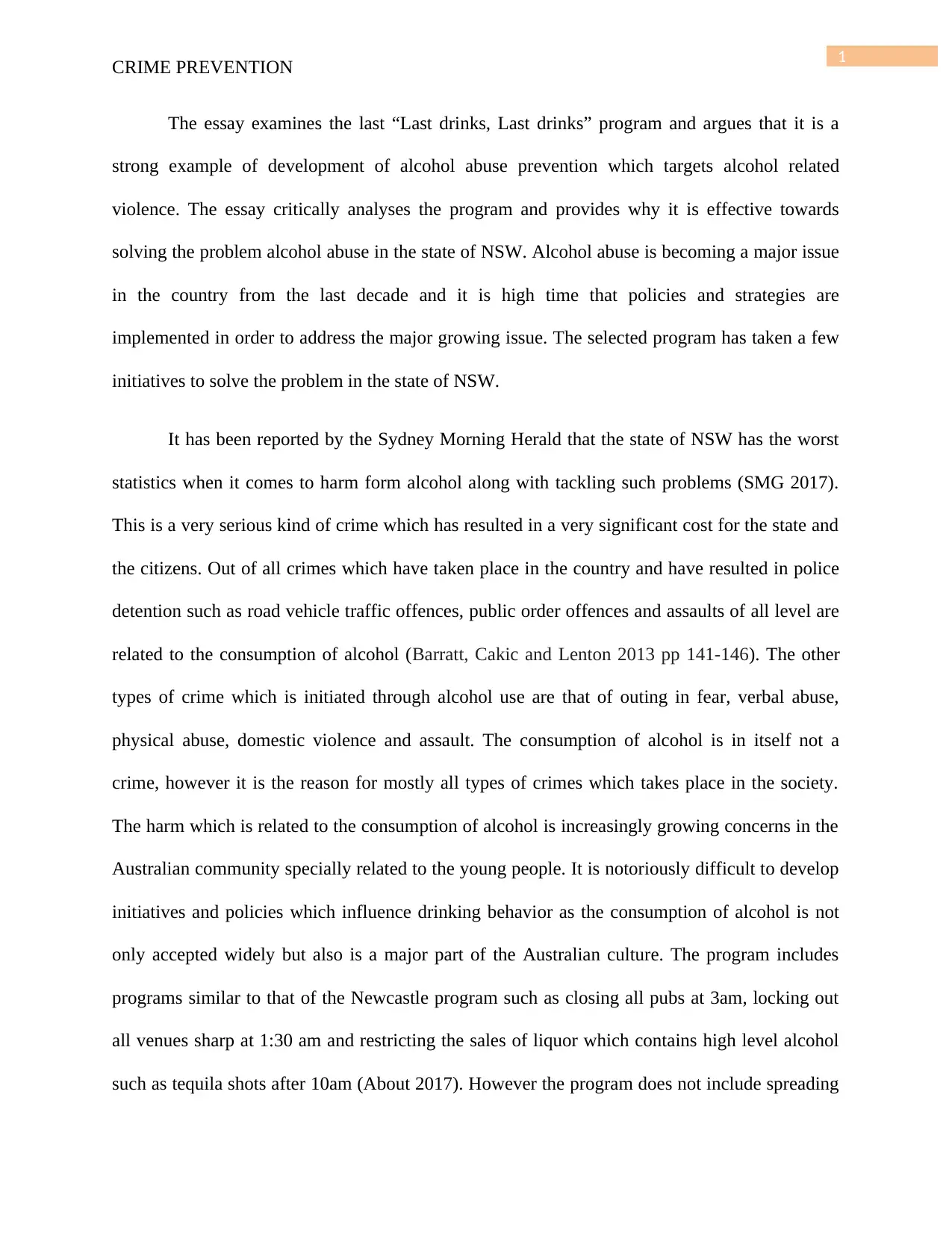
1
CRIME PREVENTION
The essay examines the last “Last drinks, Last drinks” program and argues that it is a
strong example of development of alcohol abuse prevention which targets alcohol related
violence. The essay critically analyses the program and provides why it is effective towards
solving the problem alcohol abuse in the state of NSW. Alcohol abuse is becoming a major issue
in the country from the last decade and it is high time that policies and strategies are
implemented in order to address the major growing issue. The selected program has taken a few
initiatives to solve the problem in the state of NSW.
It has been reported by the Sydney Morning Herald that the state of NSW has the worst
statistics when it comes to harm form alcohol along with tackling such problems (SMG 2017).
This is a very serious kind of crime which has resulted in a very significant cost for the state and
the citizens. Out of all crimes which have taken place in the country and have resulted in police
detention such as road vehicle traffic offences, public order offences and assaults of all level are
related to the consumption of alcohol (Barratt, Cakic and Lenton 2013 pp 141-146). The other
types of crime which is initiated through alcohol use are that of outing in fear, verbal abuse,
physical abuse, domestic violence and assault. The consumption of alcohol is in itself not a
crime, however it is the reason for mostly all types of crimes which takes place in the society.
The harm which is related to the consumption of alcohol is increasingly growing concerns in the
Australian community specially related to the young people. It is notoriously difficult to develop
initiatives and policies which influence drinking behavior as the consumption of alcohol is not
only accepted widely but also is a major part of the Australian culture. The program includes
programs similar to that of the Newcastle program such as closing all pubs at 3am, locking out
all venues sharp at 1:30 am and restricting the sales of liquor which contains high level alcohol
such as tequila shots after 10am (About 2017). However the program does not include spreading
CRIME PREVENTION
The essay examines the last “Last drinks, Last drinks” program and argues that it is a
strong example of development of alcohol abuse prevention which targets alcohol related
violence. The essay critically analyses the program and provides why it is effective towards
solving the problem alcohol abuse in the state of NSW. Alcohol abuse is becoming a major issue
in the country from the last decade and it is high time that policies and strategies are
implemented in order to address the major growing issue. The selected program has taken a few
initiatives to solve the problem in the state of NSW.
It has been reported by the Sydney Morning Herald that the state of NSW has the worst
statistics when it comes to harm form alcohol along with tackling such problems (SMG 2017).
This is a very serious kind of crime which has resulted in a very significant cost for the state and
the citizens. Out of all crimes which have taken place in the country and have resulted in police
detention such as road vehicle traffic offences, public order offences and assaults of all level are
related to the consumption of alcohol (Barratt, Cakic and Lenton 2013 pp 141-146). The other
types of crime which is initiated through alcohol use are that of outing in fear, verbal abuse,
physical abuse, domestic violence and assault. The consumption of alcohol is in itself not a
crime, however it is the reason for mostly all types of crimes which takes place in the society.
The harm which is related to the consumption of alcohol is increasingly growing concerns in the
Australian community specially related to the young people. It is notoriously difficult to develop
initiatives and policies which influence drinking behavior as the consumption of alcohol is not
only accepted widely but also is a major part of the Australian culture. The program includes
programs similar to that of the Newcastle program such as closing all pubs at 3am, locking out
all venues sharp at 1:30 am and restricting the sales of liquor which contains high level alcohol
such as tequila shots after 10am (About 2017). However the program does not include spreading
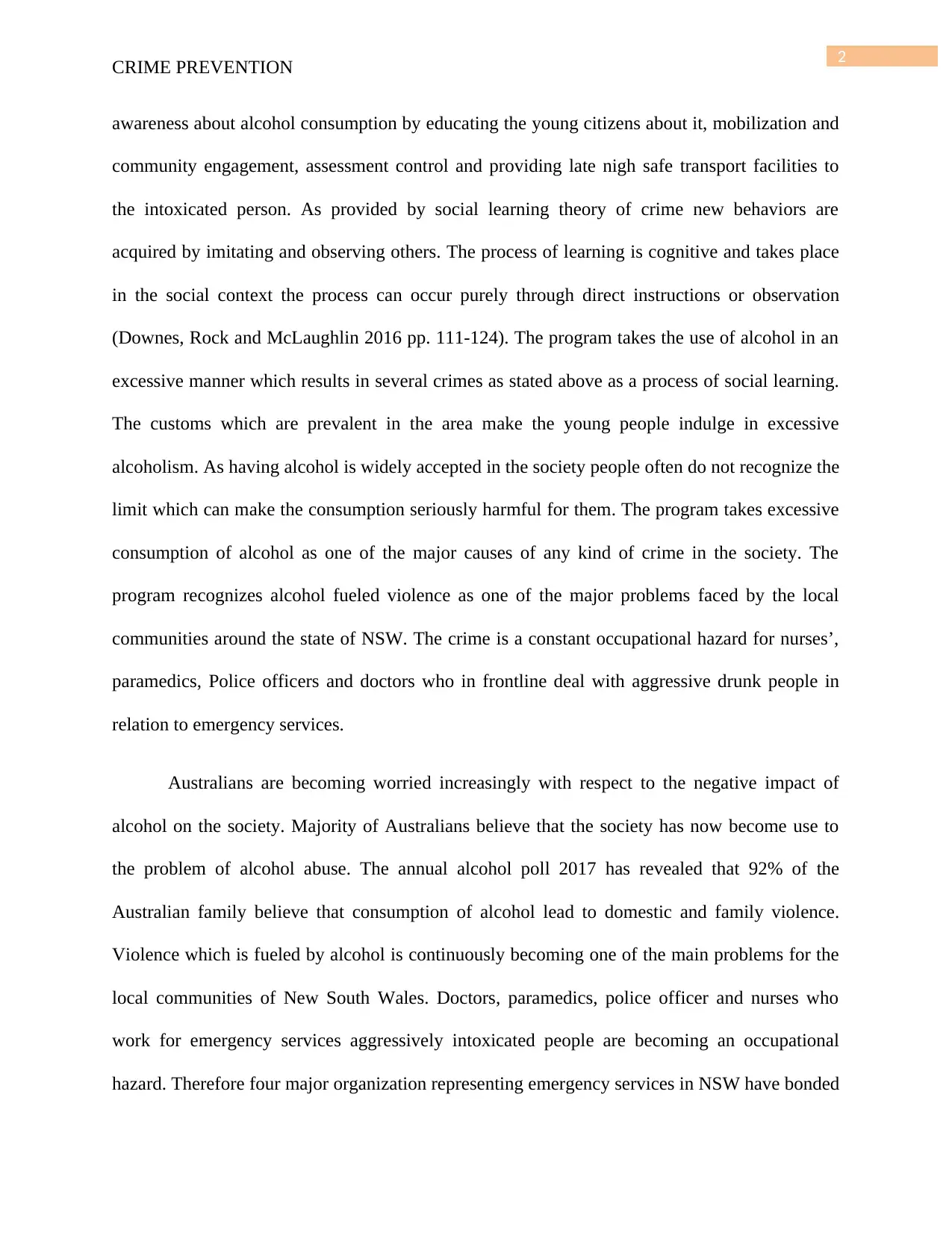
2
CRIME PREVENTION
awareness about alcohol consumption by educating the young citizens about it, mobilization and
community engagement, assessment control and providing late nigh safe transport facilities to
the intoxicated person. As provided by social learning theory of crime new behaviors are
acquired by imitating and observing others. The process of learning is cognitive and takes place
in the social context the process can occur purely through direct instructions or observation
(Downes, Rock and McLaughlin 2016 pp. 111-124). The program takes the use of alcohol in an
excessive manner which results in several crimes as stated above as a process of social learning.
The customs which are prevalent in the area make the young people indulge in excessive
alcoholism. As having alcohol is widely accepted in the society people often do not recognize the
limit which can make the consumption seriously harmful for them. The program takes excessive
consumption of alcohol as one of the major causes of any kind of crime in the society. The
program recognizes alcohol fueled violence as one of the major problems faced by the local
communities around the state of NSW. The crime is a constant occupational hazard for nurses’,
paramedics, Police officers and doctors who in frontline deal with aggressive drunk people in
relation to emergency services.
Australians are becoming worried increasingly with respect to the negative impact of
alcohol on the society. Majority of Australians believe that the society has now become use to
the problem of alcohol abuse. The annual alcohol poll 2017 has revealed that 92% of the
Australian family believe that consumption of alcohol lead to domestic and family violence.
Violence which is fueled by alcohol is continuously becoming one of the main problems for the
local communities of New South Wales. Doctors, paramedics, police officer and nurses who
work for emergency services aggressively intoxicated people are becoming an occupational
hazard. Therefore four major organization representing emergency services in NSW have bonded
CRIME PREVENTION
awareness about alcohol consumption by educating the young citizens about it, mobilization and
community engagement, assessment control and providing late nigh safe transport facilities to
the intoxicated person. As provided by social learning theory of crime new behaviors are
acquired by imitating and observing others. The process of learning is cognitive and takes place
in the social context the process can occur purely through direct instructions or observation
(Downes, Rock and McLaughlin 2016 pp. 111-124). The program takes the use of alcohol in an
excessive manner which results in several crimes as stated above as a process of social learning.
The customs which are prevalent in the area make the young people indulge in excessive
alcoholism. As having alcohol is widely accepted in the society people often do not recognize the
limit which can make the consumption seriously harmful for them. The program takes excessive
consumption of alcohol as one of the major causes of any kind of crime in the society. The
program recognizes alcohol fueled violence as one of the major problems faced by the local
communities around the state of NSW. The crime is a constant occupational hazard for nurses’,
paramedics, Police officers and doctors who in frontline deal with aggressive drunk people in
relation to emergency services.
Australians are becoming worried increasingly with respect to the negative impact of
alcohol on the society. Majority of Australians believe that the society has now become use to
the problem of alcohol abuse. The annual alcohol poll 2017 has revealed that 92% of the
Australian family believe that consumption of alcohol lead to domestic and family violence.
Violence which is fueled by alcohol is continuously becoming one of the main problems for the
local communities of New South Wales. Doctors, paramedics, police officer and nurses who
work for emergency services aggressively intoxicated people are becoming an occupational
hazard. Therefore four major organization representing emergency services in NSW have bonded
⊘ This is a preview!⊘
Do you want full access?
Subscribe today to unlock all pages.

Trusted by 1+ million students worldwide
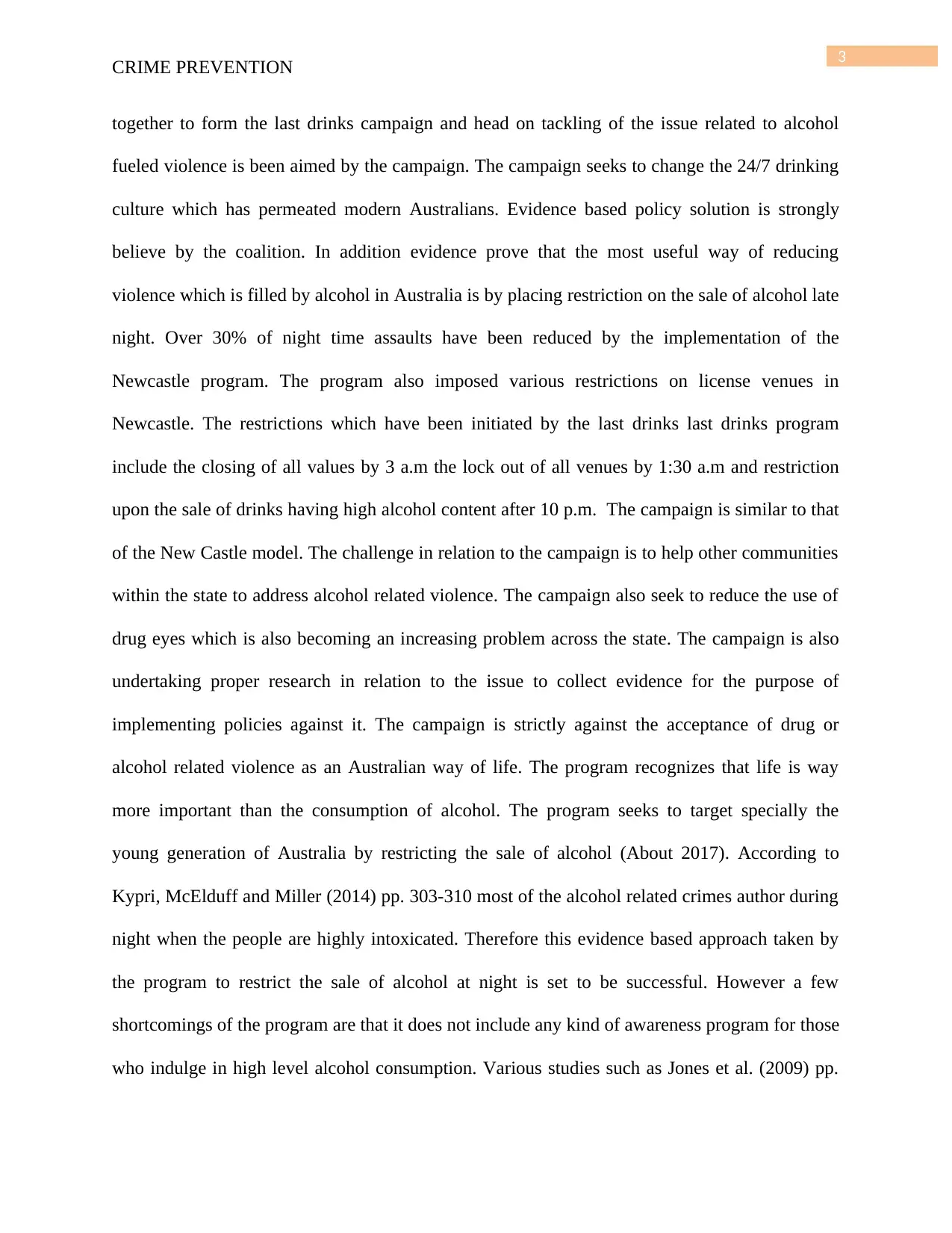
3
CRIME PREVENTION
together to form the last drinks campaign and head on tackling of the issue related to alcohol
fueled violence is been aimed by the campaign. The campaign seeks to change the 24/7 drinking
culture which has permeated modern Australians. Evidence based policy solution is strongly
believe by the coalition. In addition evidence prove that the most useful way of reducing
violence which is filled by alcohol in Australia is by placing restriction on the sale of alcohol late
night. Over 30% of night time assaults have been reduced by the implementation of the
Newcastle program. The program also imposed various restrictions on license venues in
Newcastle. The restrictions which have been initiated by the last drinks last drinks program
include the closing of all values by 3 a.m the lock out of all venues by 1:30 a.m and restriction
upon the sale of drinks having high alcohol content after 10 p.m. The campaign is similar to that
of the New Castle model. The challenge in relation to the campaign is to help other communities
within the state to address alcohol related violence. The campaign also seek to reduce the use of
drug eyes which is also becoming an increasing problem across the state. The campaign is also
undertaking proper research in relation to the issue to collect evidence for the purpose of
implementing policies against it. The campaign is strictly against the acceptance of drug or
alcohol related violence as an Australian way of life. The program recognizes that life is way
more important than the consumption of alcohol. The program seeks to target specially the
young generation of Australia by restricting the sale of alcohol (About 2017). According to
Kypri, McElduff and Miller (2014) pp. 303-310 most of the alcohol related crimes author during
night when the people are highly intoxicated. Therefore this evidence based approach taken by
the program to restrict the sale of alcohol at night is set to be successful. However a few
shortcomings of the program are that it does not include any kind of awareness program for those
who indulge in high level alcohol consumption. Various studies such as Jones et al. (2009) pp.
CRIME PREVENTION
together to form the last drinks campaign and head on tackling of the issue related to alcohol
fueled violence is been aimed by the campaign. The campaign seeks to change the 24/7 drinking
culture which has permeated modern Australians. Evidence based policy solution is strongly
believe by the coalition. In addition evidence prove that the most useful way of reducing
violence which is filled by alcohol in Australia is by placing restriction on the sale of alcohol late
night. Over 30% of night time assaults have been reduced by the implementation of the
Newcastle program. The program also imposed various restrictions on license venues in
Newcastle. The restrictions which have been initiated by the last drinks last drinks program
include the closing of all values by 3 a.m the lock out of all venues by 1:30 a.m and restriction
upon the sale of drinks having high alcohol content after 10 p.m. The campaign is similar to that
of the New Castle model. The challenge in relation to the campaign is to help other communities
within the state to address alcohol related violence. The campaign also seek to reduce the use of
drug eyes which is also becoming an increasing problem across the state. The campaign is also
undertaking proper research in relation to the issue to collect evidence for the purpose of
implementing policies against it. The campaign is strictly against the acceptance of drug or
alcohol related violence as an Australian way of life. The program recognizes that life is way
more important than the consumption of alcohol. The program seeks to target specially the
young generation of Australia by restricting the sale of alcohol (About 2017). According to
Kypri, McElduff and Miller (2014) pp. 303-310 most of the alcohol related crimes author during
night when the people are highly intoxicated. Therefore this evidence based approach taken by
the program to restrict the sale of alcohol at night is set to be successful. However a few
shortcomings of the program are that it does not include any kind of awareness program for those
who indulge in high level alcohol consumption. Various studies such as Jones et al. (2009) pp.
Paraphrase This Document
Need a fresh take? Get an instant paraphrase of this document with our AI Paraphraser
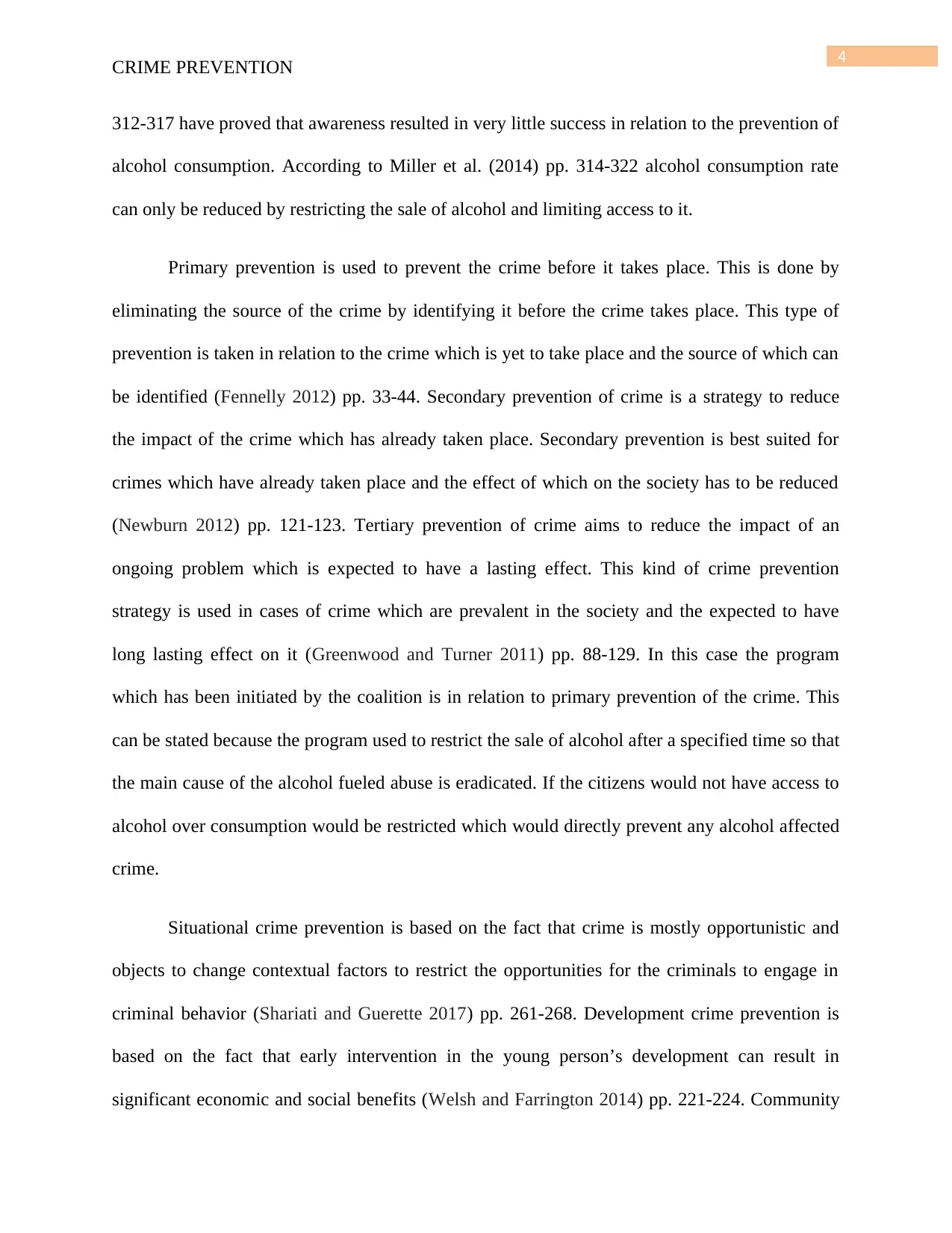
4
CRIME PREVENTION
312-317 have proved that awareness resulted in very little success in relation to the prevention of
alcohol consumption. According to Miller et al. (2014) pp. 314-322 alcohol consumption rate
can only be reduced by restricting the sale of alcohol and limiting access to it.
Primary prevention is used to prevent the crime before it takes place. This is done by
eliminating the source of the crime by identifying it before the crime takes place. This type of
prevention is taken in relation to the crime which is yet to take place and the source of which can
be identified (Fennelly 2012) pp. 33-44. Secondary prevention of crime is a strategy to reduce
the impact of the crime which has already taken place. Secondary prevention is best suited for
crimes which have already taken place and the effect of which on the society has to be reduced
(Newburn 2012) pp. 121-123. Tertiary prevention of crime aims to reduce the impact of an
ongoing problem which is expected to have a lasting effect. This kind of crime prevention
strategy is used in cases of crime which are prevalent in the society and the expected to have
long lasting effect on it (Greenwood and Turner 2011) pp. 88-129. In this case the program
which has been initiated by the coalition is in relation to primary prevention of the crime. This
can be stated because the program used to restrict the sale of alcohol after a specified time so that
the main cause of the alcohol fueled abuse is eradicated. If the citizens would not have access to
alcohol over consumption would be restricted which would directly prevent any alcohol affected
crime.
Situational crime prevention is based on the fact that crime is mostly opportunistic and
objects to change contextual factors to restrict the opportunities for the criminals to engage in
criminal behavior (Shariati and Guerette 2017) pp. 261-268. Development crime prevention is
based on the fact that early intervention in the young person’s development can result in
significant economic and social benefits (Welsh and Farrington 2014) pp. 221-224. Community
CRIME PREVENTION
312-317 have proved that awareness resulted in very little success in relation to the prevention of
alcohol consumption. According to Miller et al. (2014) pp. 314-322 alcohol consumption rate
can only be reduced by restricting the sale of alcohol and limiting access to it.
Primary prevention is used to prevent the crime before it takes place. This is done by
eliminating the source of the crime by identifying it before the crime takes place. This type of
prevention is taken in relation to the crime which is yet to take place and the source of which can
be identified (Fennelly 2012) pp. 33-44. Secondary prevention of crime is a strategy to reduce
the impact of the crime which has already taken place. Secondary prevention is best suited for
crimes which have already taken place and the effect of which on the society has to be reduced
(Newburn 2012) pp. 121-123. Tertiary prevention of crime aims to reduce the impact of an
ongoing problem which is expected to have a lasting effect. This kind of crime prevention
strategy is used in cases of crime which are prevalent in the society and the expected to have
long lasting effect on it (Greenwood and Turner 2011) pp. 88-129. In this case the program
which has been initiated by the coalition is in relation to primary prevention of the crime. This
can be stated because the program used to restrict the sale of alcohol after a specified time so that
the main cause of the alcohol fueled abuse is eradicated. If the citizens would not have access to
alcohol over consumption would be restricted which would directly prevent any alcohol affected
crime.
Situational crime prevention is based on the fact that crime is mostly opportunistic and
objects to change contextual factors to restrict the opportunities for the criminals to engage in
criminal behavior (Shariati and Guerette 2017) pp. 261-268. Development crime prevention is
based on the fact that early intervention in the young person’s development can result in
significant economic and social benefits (Welsh and Farrington 2014) pp. 221-224. Community
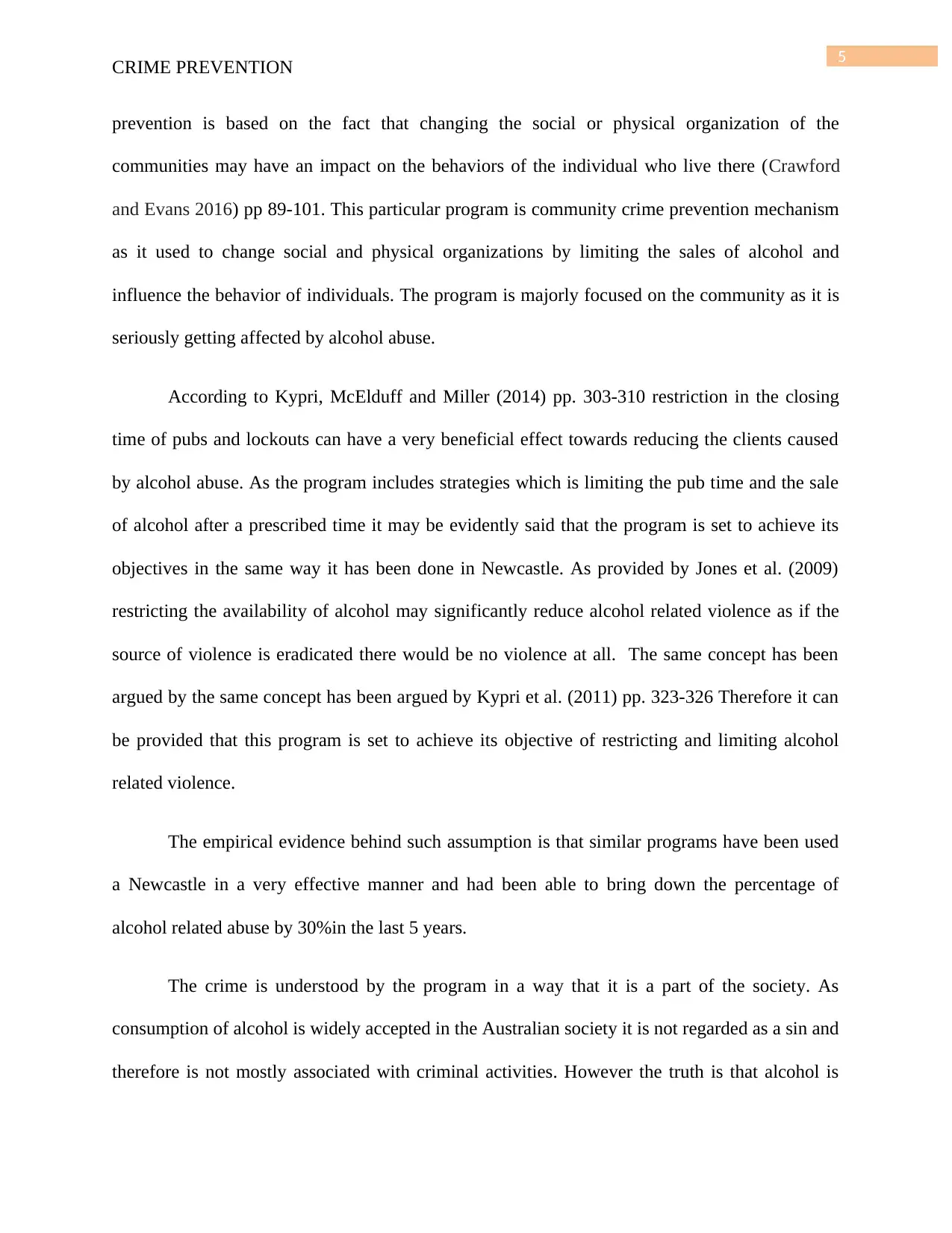
5
CRIME PREVENTION
prevention is based on the fact that changing the social or physical organization of the
communities may have an impact on the behaviors of the individual who live there (Crawford
and Evans 2016) pp 89-101. This particular program is community crime prevention mechanism
as it used to change social and physical organizations by limiting the sales of alcohol and
influence the behavior of individuals. The program is majorly focused on the community as it is
seriously getting affected by alcohol abuse.
According to Kypri, McElduff and Miller (2014) pp. 303-310 restriction in the closing
time of pubs and lockouts can have a very beneficial effect towards reducing the clients caused
by alcohol abuse. As the program includes strategies which is limiting the pub time and the sale
of alcohol after a prescribed time it may be evidently said that the program is set to achieve its
objectives in the same way it has been done in Newcastle. As provided by Jones et al. (2009)
restricting the availability of alcohol may significantly reduce alcohol related violence as if the
source of violence is eradicated there would be no violence at all. The same concept has been
argued by the same concept has been argued by Kypri et al. (2011) pp. 323-326 Therefore it can
be provided that this program is set to achieve its objective of restricting and limiting alcohol
related violence.
The empirical evidence behind such assumption is that similar programs have been used
a Newcastle in a very effective manner and had been able to bring down the percentage of
alcohol related abuse by 30%in the last 5 years.
The crime is understood by the program in a way that it is a part of the society. As
consumption of alcohol is widely accepted in the Australian society it is not regarded as a sin and
therefore is not mostly associated with criminal activities. However the truth is that alcohol is
CRIME PREVENTION
prevention is based on the fact that changing the social or physical organization of the
communities may have an impact on the behaviors of the individual who live there (Crawford
and Evans 2016) pp 89-101. This particular program is community crime prevention mechanism
as it used to change social and physical organizations by limiting the sales of alcohol and
influence the behavior of individuals. The program is majorly focused on the community as it is
seriously getting affected by alcohol abuse.
According to Kypri, McElduff and Miller (2014) pp. 303-310 restriction in the closing
time of pubs and lockouts can have a very beneficial effect towards reducing the clients caused
by alcohol abuse. As the program includes strategies which is limiting the pub time and the sale
of alcohol after a prescribed time it may be evidently said that the program is set to achieve its
objectives in the same way it has been done in Newcastle. As provided by Jones et al. (2009)
restricting the availability of alcohol may significantly reduce alcohol related violence as if the
source of violence is eradicated there would be no violence at all. The same concept has been
argued by the same concept has been argued by Kypri et al. (2011) pp. 323-326 Therefore it can
be provided that this program is set to achieve its objective of restricting and limiting alcohol
related violence.
The empirical evidence behind such assumption is that similar programs have been used
a Newcastle in a very effective manner and had been able to bring down the percentage of
alcohol related abuse by 30%in the last 5 years.
The crime is understood by the program in a way that it is a part of the society. As
consumption of alcohol is widely accepted in the Australian society it is not regarded as a sin and
therefore is not mostly associated with criminal activities. However the truth is that alcohol is
⊘ This is a preview!⊘
Do you want full access?
Subscribe today to unlock all pages.

Trusted by 1+ million students worldwide
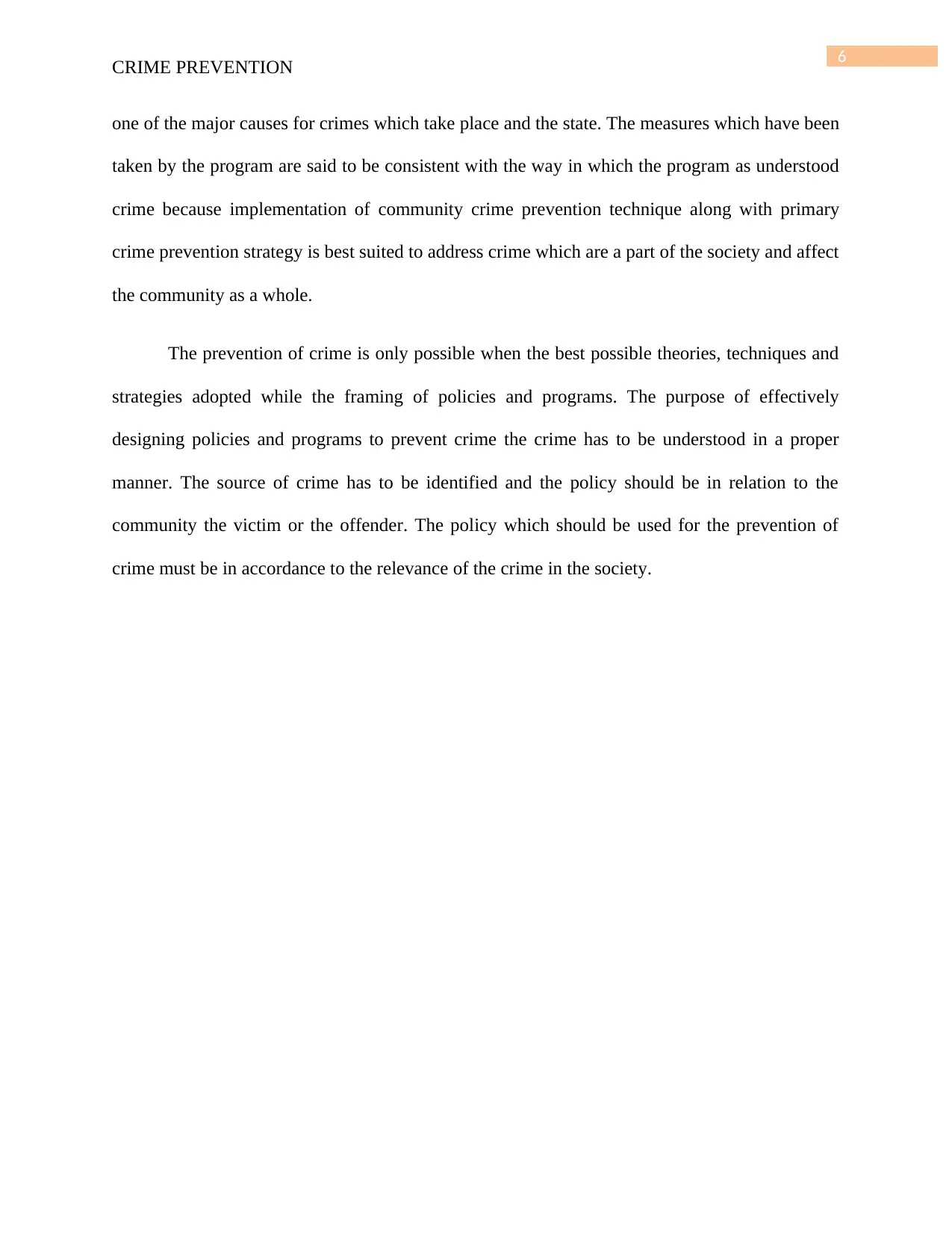
6
CRIME PREVENTION
one of the major causes for crimes which take place and the state. The measures which have been
taken by the program are said to be consistent with the way in which the program as understood
crime because implementation of community crime prevention technique along with primary
crime prevention strategy is best suited to address crime which are a part of the society and affect
the community as a whole.
The prevention of crime is only possible when the best possible theories, techniques and
strategies adopted while the framing of policies and programs. The purpose of effectively
designing policies and programs to prevent crime the crime has to be understood in a proper
manner. The source of crime has to be identified and the policy should be in relation to the
community the victim or the offender. The policy which should be used for the prevention of
crime must be in accordance to the relevance of the crime in the society.
CRIME PREVENTION
one of the major causes for crimes which take place and the state. The measures which have been
taken by the program are said to be consistent with the way in which the program as understood
crime because implementation of community crime prevention technique along with primary
crime prevention strategy is best suited to address crime which are a part of the society and affect
the community as a whole.
The prevention of crime is only possible when the best possible theories, techniques and
strategies adopted while the framing of policies and programs. The purpose of effectively
designing policies and programs to prevent crime the crime has to be understood in a proper
manner. The source of crime has to be identified and the policy should be in relation to the
community the victim or the offender. The policy which should be used for the prevention of
crime must be in accordance to the relevance of the crime in the society.
Paraphrase This Document
Need a fresh take? Get an instant paraphrase of this document with our AI Paraphraser
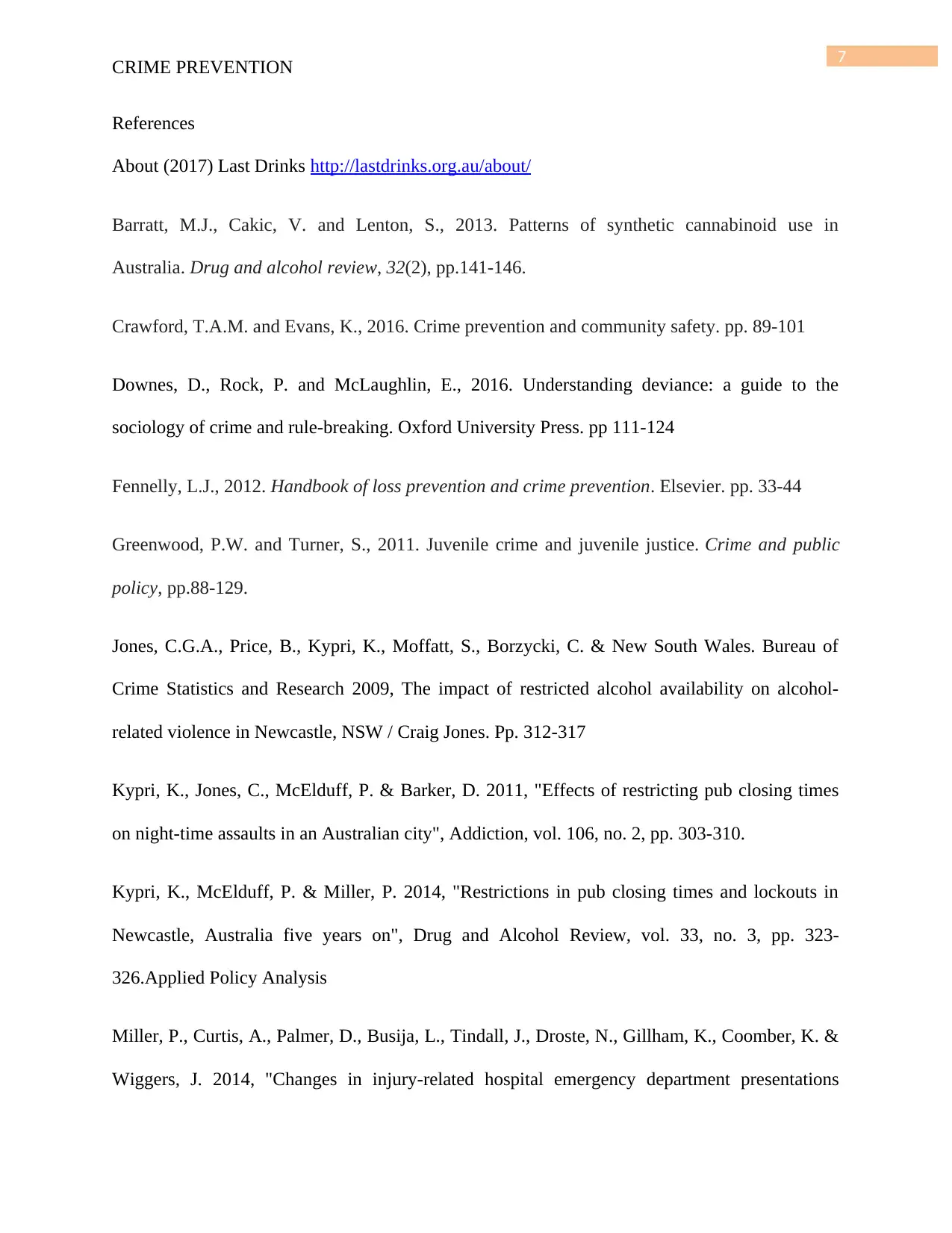
7
CRIME PREVENTION
References
About (2017) Last Drinks http://lastdrinks.org.au/about/
Barratt, M.J., Cakic, V. and Lenton, S., 2013. Patterns of synthetic cannabinoid use in
Australia. Drug and alcohol review, 32(2), pp.141-146.
Crawford, T.A.M. and Evans, K., 2016. Crime prevention and community safety. pp. 89-101
Downes, D., Rock, P. and McLaughlin, E., 2016. Understanding deviance: a guide to the
sociology of crime and rule-breaking. Oxford University Press. pp 111-124
Fennelly, L.J., 2012. Handbook of loss prevention and crime prevention. Elsevier. pp. 33-44
Greenwood, P.W. and Turner, S., 2011. Juvenile crime and juvenile justice. Crime and public
policy, pp.88-129.
Jones, C.G.A., Price, B., Kypri, K., Moffatt, S., Borzycki, C. & New South Wales. Bureau of
Crime Statistics and Research 2009, The impact of restricted alcohol availability on alcohol-
related violence in Newcastle, NSW / Craig Jones. Pp. 312-317
Kypri, K., Jones, C., McElduff, P. & Barker, D. 2011, "Effects of restricting pub closing times
on night‐time assaults in an Australian city", Addiction, vol. 106, no. 2, pp. 303-310.
Kypri, K., McElduff, P. & Miller, P. 2014, "Restrictions in pub closing times and lockouts in
Newcastle, Australia five years on", Drug and Alcohol Review, vol. 33, no. 3, pp. 323-
326.Applied Policy Analysis
Miller, P., Curtis, A., Palmer, D., Busija, L., Tindall, J., Droste, N., Gillham, K., Coomber, K. &
Wiggers, J. 2014, "Changes in injury‐related hospital emergency department presentations
CRIME PREVENTION
References
About (2017) Last Drinks http://lastdrinks.org.au/about/
Barratt, M.J., Cakic, V. and Lenton, S., 2013. Patterns of synthetic cannabinoid use in
Australia. Drug and alcohol review, 32(2), pp.141-146.
Crawford, T.A.M. and Evans, K., 2016. Crime prevention and community safety. pp. 89-101
Downes, D., Rock, P. and McLaughlin, E., 2016. Understanding deviance: a guide to the
sociology of crime and rule-breaking. Oxford University Press. pp 111-124
Fennelly, L.J., 2012. Handbook of loss prevention and crime prevention. Elsevier. pp. 33-44
Greenwood, P.W. and Turner, S., 2011. Juvenile crime and juvenile justice. Crime and public
policy, pp.88-129.
Jones, C.G.A., Price, B., Kypri, K., Moffatt, S., Borzycki, C. & New South Wales. Bureau of
Crime Statistics and Research 2009, The impact of restricted alcohol availability on alcohol-
related violence in Newcastle, NSW / Craig Jones. Pp. 312-317
Kypri, K., Jones, C., McElduff, P. & Barker, D. 2011, "Effects of restricting pub closing times
on night‐time assaults in an Australian city", Addiction, vol. 106, no. 2, pp. 303-310.
Kypri, K., McElduff, P. & Miller, P. 2014, "Restrictions in pub closing times and lockouts in
Newcastle, Australia five years on", Drug and Alcohol Review, vol. 33, no. 3, pp. 323-
326.Applied Policy Analysis
Miller, P., Curtis, A., Palmer, D., Busija, L., Tindall, J., Droste, N., Gillham, K., Coomber, K. &
Wiggers, J. 2014, "Changes in injury‐related hospital emergency department presentations
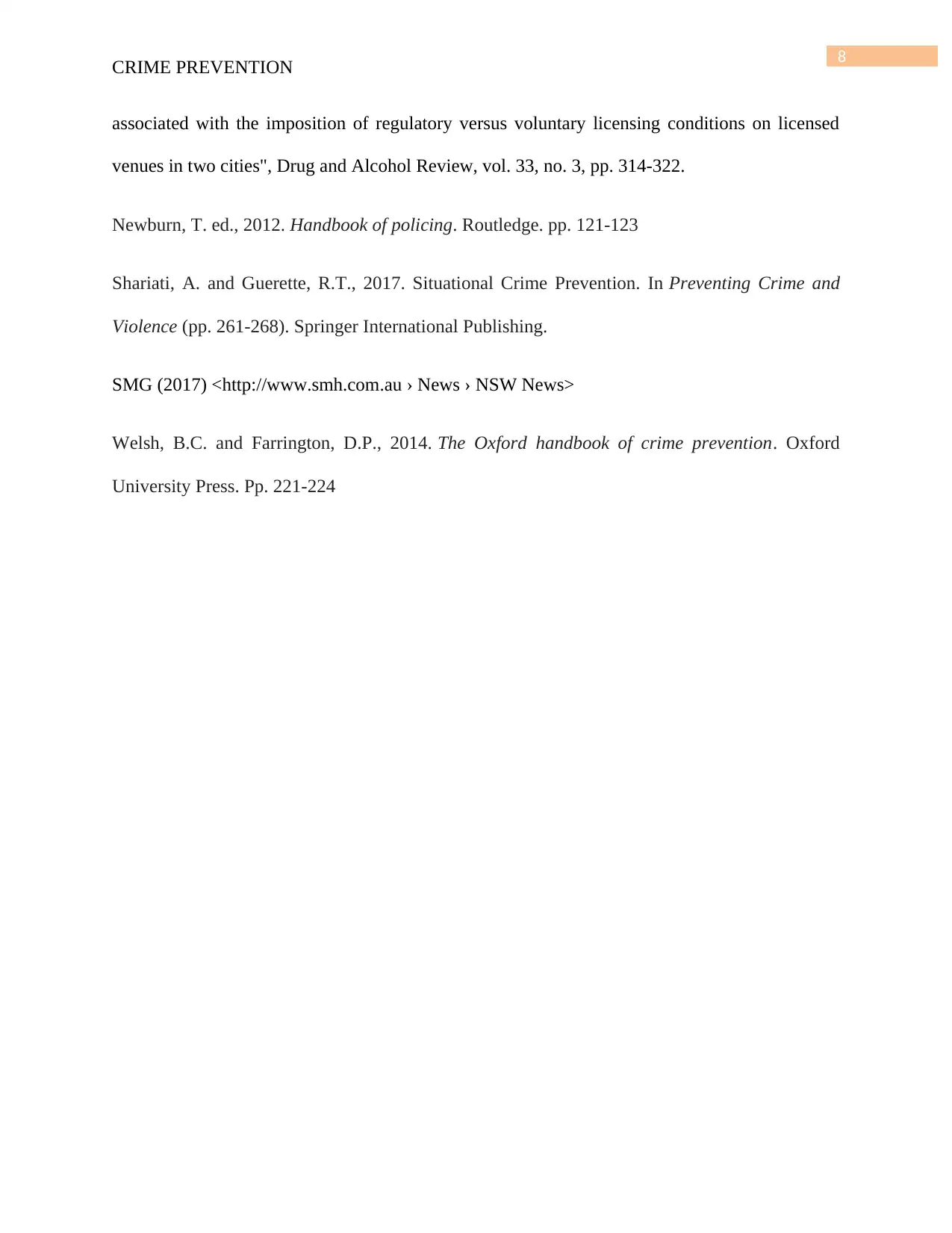
8
CRIME PREVENTION
associated with the imposition of regulatory versus voluntary licensing conditions on licensed
venues in two cities", Drug and Alcohol Review, vol. 33, no. 3, pp. 314-322.
Newburn, T. ed., 2012. Handbook of policing. Routledge. pp. 121-123
Shariati, A. and Guerette, R.T., 2017. Situational Crime Prevention. In Preventing Crime and
Violence (pp. 261-268). Springer International Publishing.
SMG (2017) <http://www.smh.com.au › News › NSW News>
Welsh, B.C. and Farrington, D.P., 2014. The Oxford handbook of crime prevention. Oxford
University Press. Pp. 221-224
CRIME PREVENTION
associated with the imposition of regulatory versus voluntary licensing conditions on licensed
venues in two cities", Drug and Alcohol Review, vol. 33, no. 3, pp. 314-322.
Newburn, T. ed., 2012. Handbook of policing. Routledge. pp. 121-123
Shariati, A. and Guerette, R.T., 2017. Situational Crime Prevention. In Preventing Crime and
Violence (pp. 261-268). Springer International Publishing.
SMG (2017) <http://www.smh.com.au › News › NSW News>
Welsh, B.C. and Farrington, D.P., 2014. The Oxford handbook of crime prevention. Oxford
University Press. Pp. 221-224
⊘ This is a preview!⊘
Do you want full access?
Subscribe today to unlock all pages.

Trusted by 1+ million students worldwide
1 out of 9
Related Documents
Your All-in-One AI-Powered Toolkit for Academic Success.
+13062052269
info@desklib.com
Available 24*7 on WhatsApp / Email
![[object Object]](/_next/static/media/star-bottom.7253800d.svg)
Unlock your academic potential
Copyright © 2020–2025 A2Z Services. All Rights Reserved. Developed and managed by ZUCOL.




